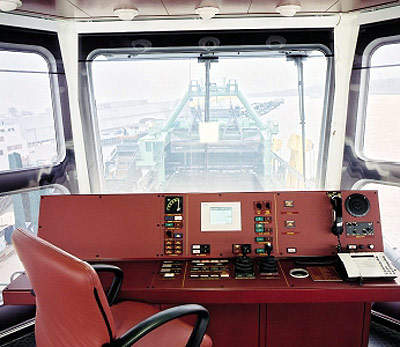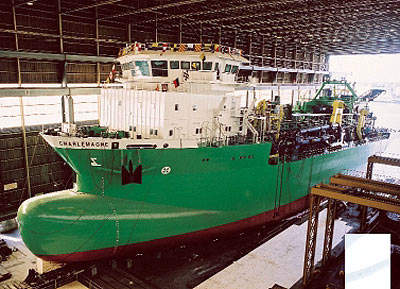The Charlemagne twin-screw aggregate dredger was built at the IHC shipyard for the Belgian-based operator Deme Building Materials (DMB). The trailing suction hopper dredger is primarily designed to win, transport and discharge sand and gravel for the
construction industry.
The vessel has an overall length of 101.3m and its length between perpendiculars is 92.5m. It has a 20.8m moulded breadth and a 9.2m moulded depth. The mean moulded draught is approximately 7.15m. The ‘dredging mark’ is 8.5m and the loading capacity
at that 8.5m draught is 10,200t. A key feature of the hull is its bulbous bow, which significantly reduces heaving and pitching and minimises the wave-induced resistance.
At the forecastle, a two-layer accommodation deckhouse can house 15 people, with the wheelhouse located above. Abaft of the wheelhouse is the 39.9m long by 11.2m wide (14.2m at tweendeck level) hopper with a 5,000m³ cargo capacity.
DREDGING
The vessel can dredge by means of a high-efficiency HRMD 141-30-70 submerged dredge pump. This pump is a three- bladed impeller system which is directly driven by a 1,700kW electric motor. This arrangement makes the dredging system 37% more powerful
than that of similar dredging installations in the aggregate market.
The pump and motor hang in an open frame support construction for easy access for maintenance and repair. The system is controlled by regulating the electric motor.
The suction tube linking the head with the vessel has a diameter of 700mm. At the top of the tube – where it enters the ship – is a hydraulically operated inlet gate valve. The length of the tube is such that it can dredge 60m below the waterline when at an angle of 60°. The flexibility is enabled by a cardan joint between the upper and lower part of the tube. This tube is lowered and retrieved using three gantries and hydraulically driven winches
The suction head is designed to remain constantly level on the seabed, even if the bed is undulating or the dredger is turning. A wire on the suction head winch is controlled by a swell compensation system with a reach of 3m, translating to a 6m movement at the suction head.
CARGO DISCHARGING
There are three discharging mechanisms for the cargo – dry, wet or dumping. In order to accommodate the grab unloading system, the aggregates are unloaded ‘dry’. The grab is hoisted and controlled using two wires, each running over a 400kW winch on top of a fixed frame.
The fully automated grab unloading system is designed for an average capacity of 1,500m³/h (2,600t/hr) using a 20m³ net volume grab. The maximum capacity at start is 1,800m³/h (3,200t/h).
To ensure that the hopper’s contents are as dry as possible, there are 12 large dewatering wells, drained by pumps. The grab deposits the aggregate on a travelling feeder conveyor-belt system.
The cargo can also be pumped to the shore by a 20ft modular dredge pump and a modular bow connection. This pump is driven by a caterpillar 3516b diesel engine with a rating of 1,491kW at 1,600rpm. A jet pump, driven by a three-speed 500kW motor, is used to fluidise the cargo.
The dumping is permitted through six single-bottom doors measuring 1,620mm by 4,600mm. Each is operated by a hydraulic system controlled remotely from the wheelhouse.
ENGINE
The Charlemagne is driven by two Wartsila Vasa 6L32 main diesel engines rated at 2,700kW at 720rpm. Each engine is connected to a Jahnel reduction gearbox to a 2,900mm diameter John Crane Lips four-bladed controllable pitch propeller located in a nozzle.
Power is provided by a pair of Imtech/Alconza AC generators. There is also an auxiliary generator consisting of a Cummins N1 4D(M) six-cylinder motor with an output of 352W at 1,800rpm driving an Alconsa generator with an output of 39,375kVA / 315kW.














